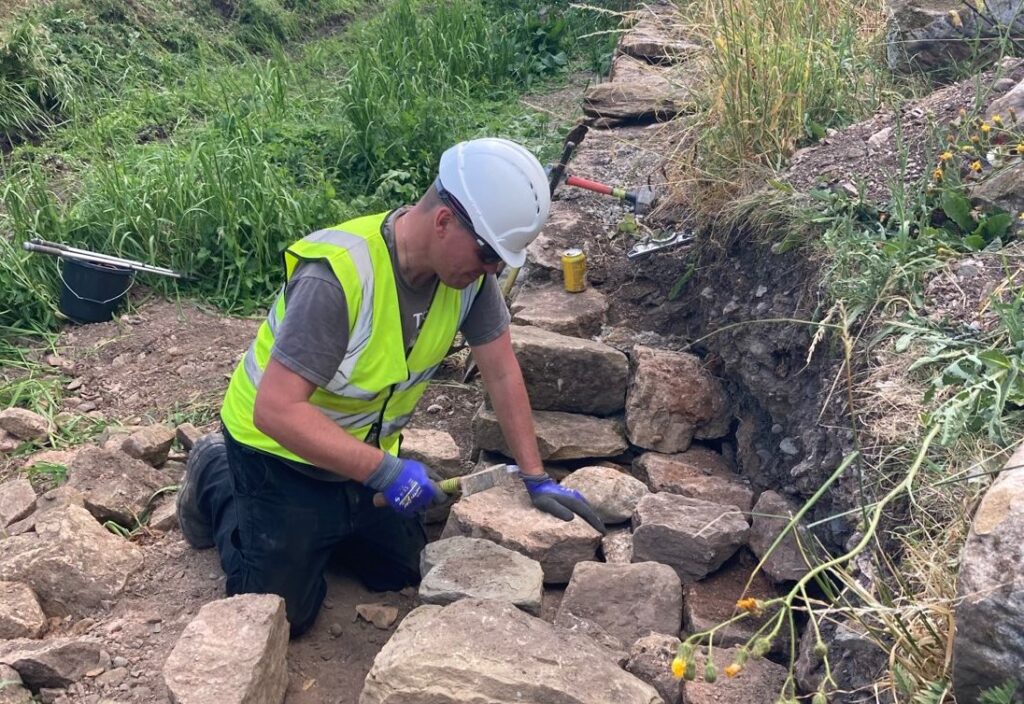Association of Industrial Archaeology awards grant for tramway wharf restoration
The Shropshire Union Canal Society gratefully acknowledges the support of a £14,600 restoration grant from the Association for Industrial Archaeology towards the cost of restoring the historic tramway wharf on the canal at Crickheath.
The canal wharf was the terminal of a 2½ mile horse-drawn tramway from the limestone quarries at Porth-y-waen. Built by navies during the construction of the canal at the end of the 18th century, it is constructed as a wide rubble stone wall using local limestone. The wharf wall is being restored as it was originally built, with members of the Dry Stone Walling Association contributing their expertise to ensure durable and high quality repairs. The wall is topped with large copings of buff and yellow sandstone/gritstone that supported the tramway rails and wagons from where stone was tipped into moored narrowboats. It is thought even back in the 18th century the copings were repurposed from elsewhere due to some variation in materials and different stonemason dressing marks. Many have crumbled and will require replacement. The stone mason dressing marks are interesting as they, once upon a time, identified the person who dressed the stone in the first place, but we don’t know if these marks were for position on the wharf or to guarantee payment to the mason.
Tom Fulda, Shropshire Union Canal Society project manager said, “We are very grateful for this generous grant, it will substantially help the project with the cost of plant hire, volunteer welfare and materials as well as promoting the work of the Association for Industrial Archaeology, the national society for industrial heritage, which has supported the study, preservation and presentation of many sites since the 70’s. If you live near the Montgomery canal, why not pop down to Crickheath and see the progress we’re making?”
The AIA promotes the study and appreciation of industrial archaeology through a program of awards and grants and promotes its aims through broad engagement with people in their early careers. It’s great that an organization such as AIA supports the restoration of the tramway wharf but what was the history of the wharf, how did it start out?
Well, the tramway, built by the Earl of Powys in around 1797 was originally known as the Porthywaen Iron Railway and was horse-drawn. It was established to take advantage of the newly built canal to move limestone from the quarries at Porthywaen and nearby Whitehaven to the wharf at Crickheath for further transit. The route ran generally westwards from Crickheath to cross both the Oswestry to Welshpool turnpike, now the A483 and the Llynclys to Porthywaen Road, the B4396 continuing west to the limestone quarries where it split into two short branches.
In 1860 the Oswestry & Newtown Railway (Later the Cambrian Railway) was opened to Pool Quay and a bridge to carry the tramway over the railway was built near Llynclys Station, next to the road bridge for the Knockin Road, the B4396. (The abutments of this bridge can still be seen from the Cambrian Heritage Railway Station.) A branch line from the railway was later built to Porthywaen and over the next 40 years or so the infrastructure varied no end as quarry working changed but it seems that both the tramway and the railway coexisted happily together, however the railway always had the upper hand and as maintenance on the canal deteriorated the writing was on the wall.
The 1926 maps show the route clearly although trade had started to dwindle by then and the tramway closed when the canal had a breach in 1936 but it is doubtful that there was much activity after 1930 due to AA Pete selling off their fleet of narrowboats at Maesbury Hall Mill. The lines were finally lifted in 1939. Although the end seems a little sad, it is to be remembered that the tramway traded successfully for some 130 years.
The The Shropshire Union Canal Society would like to thank Kenton Owen and the Oswestry Borderland Heritage website for their help and information for this article. For more research, please go to http://www.oswestry-borderland-heritage.co.uk














